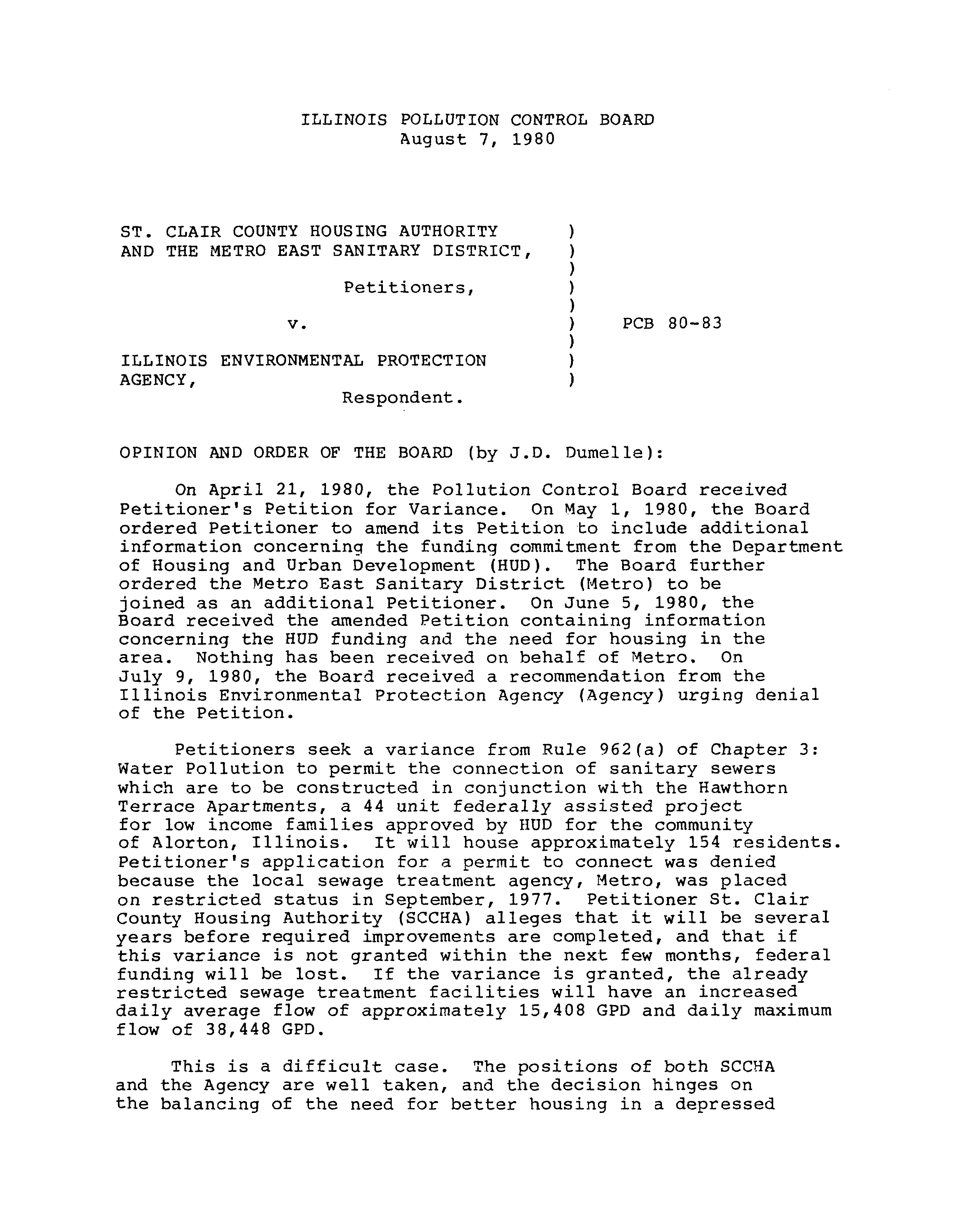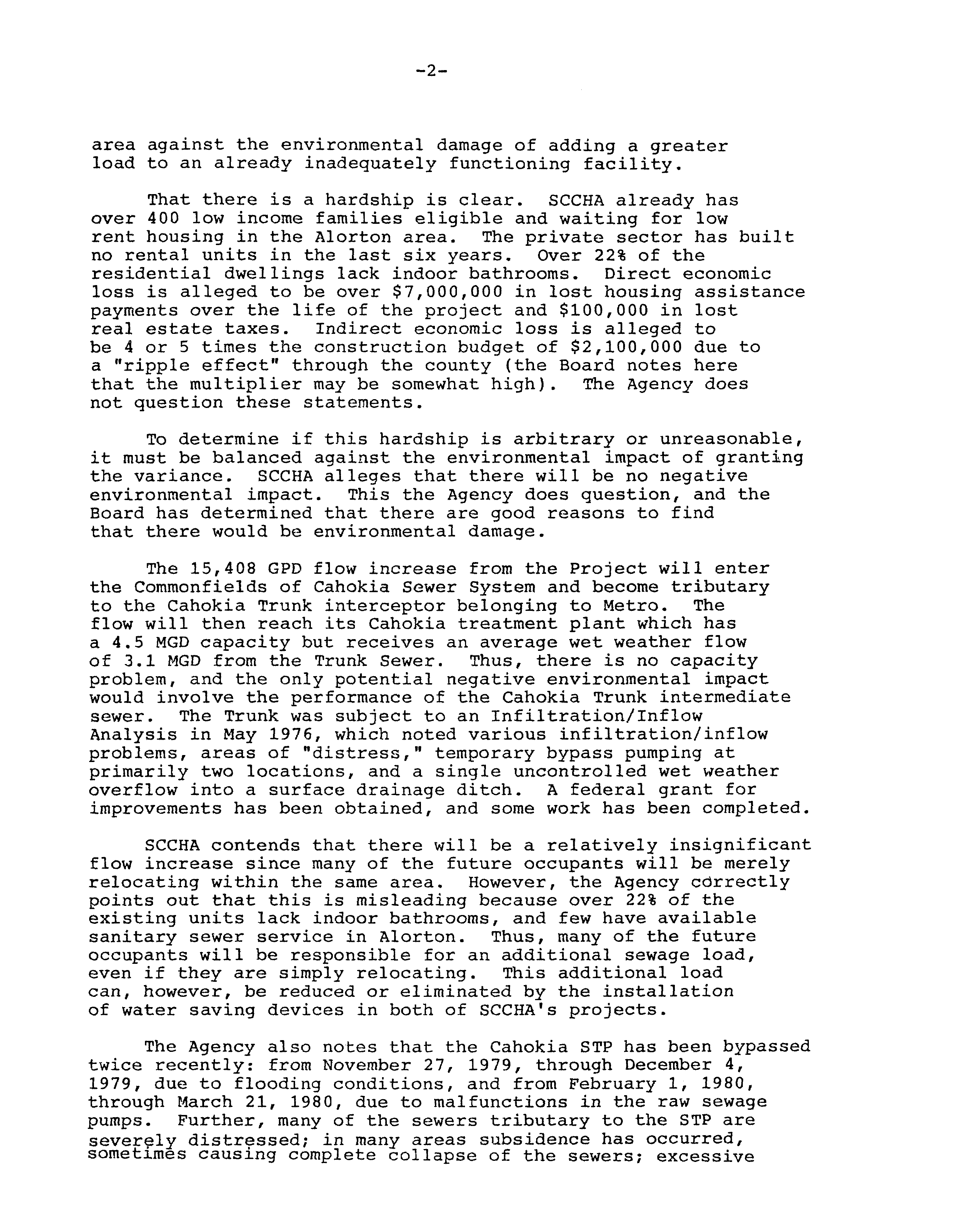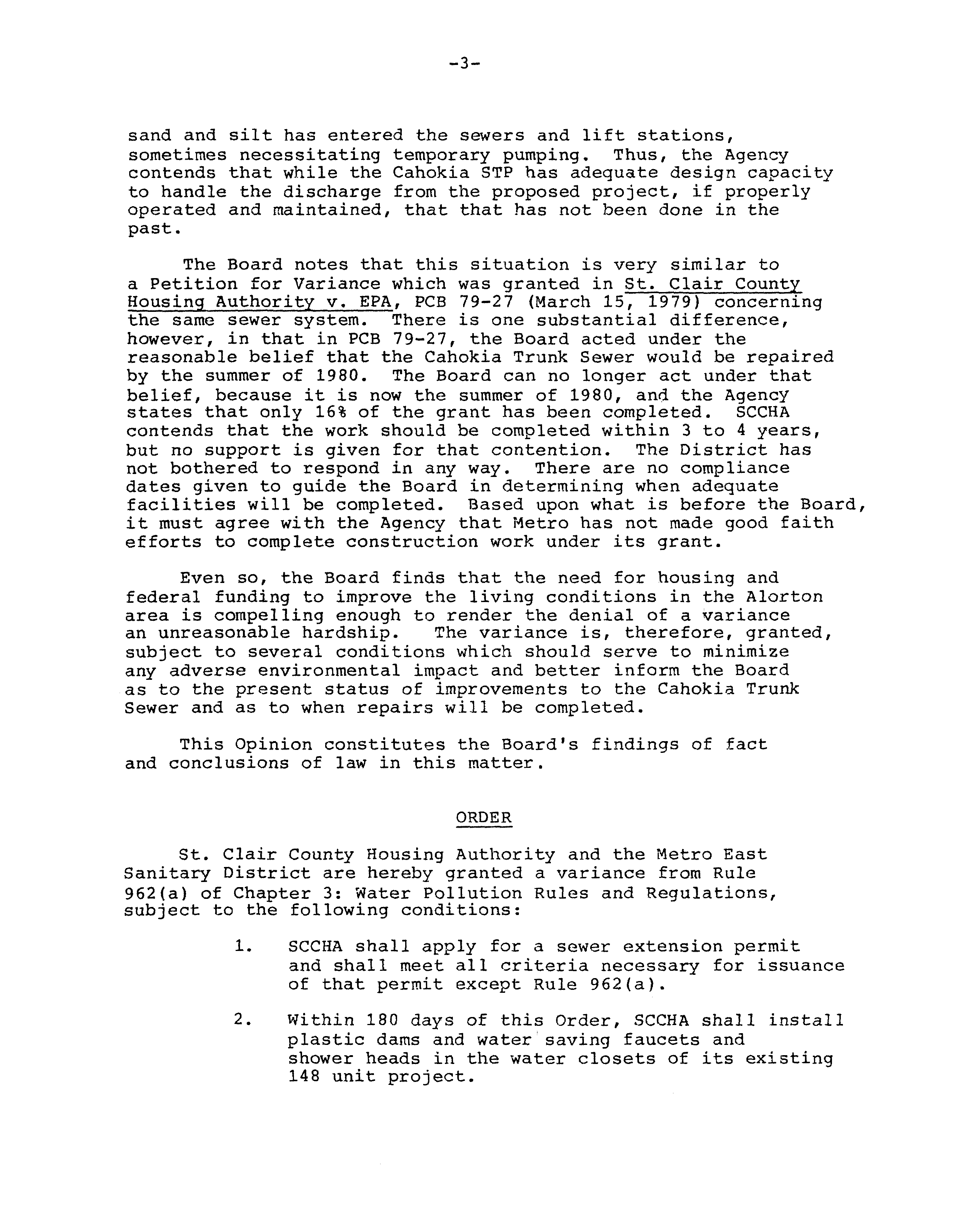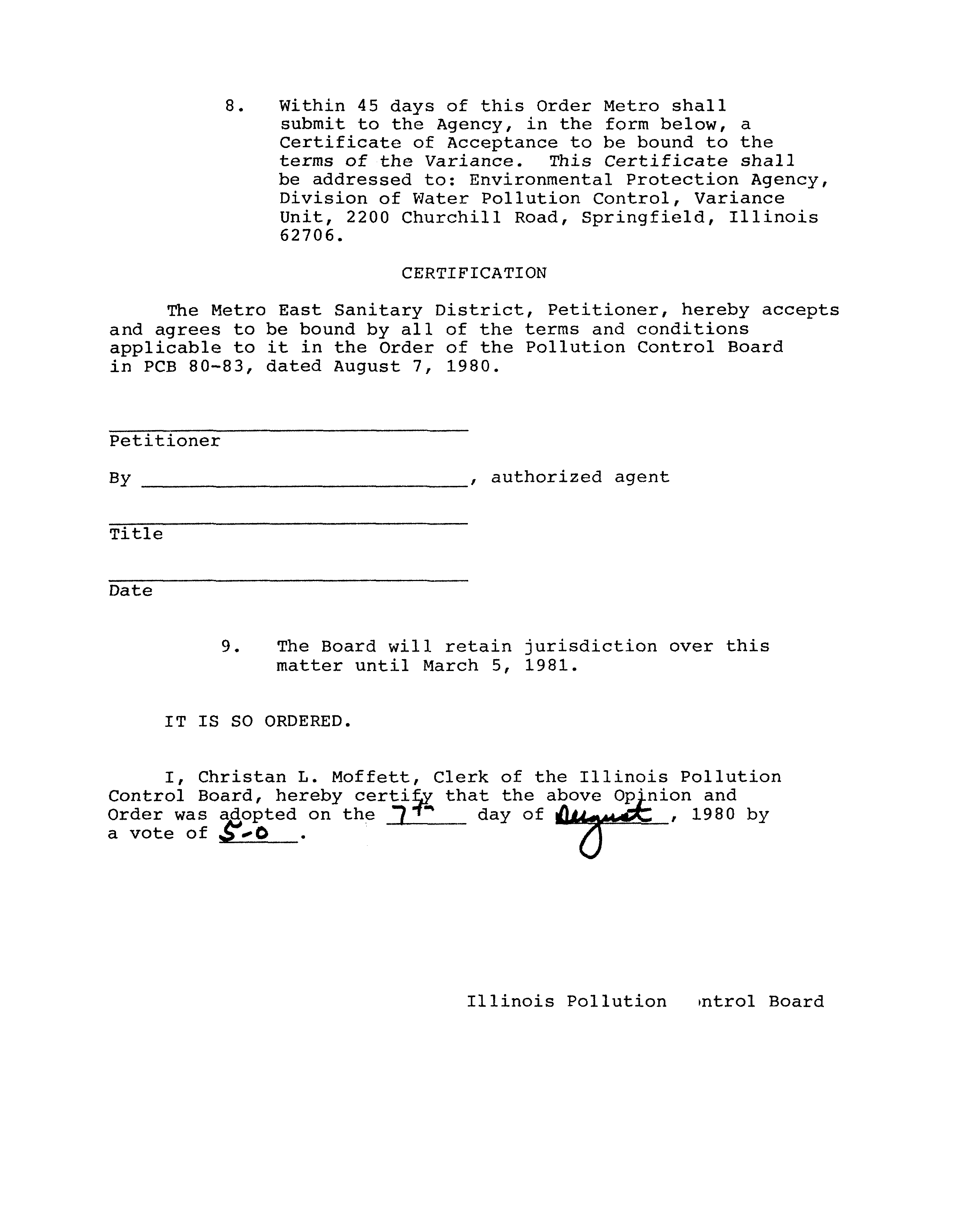ILLINOIS POLLUTION CONTROL
BOARD
august
7,
1980
ST. CLAIR COUNTY HOUSING AUTHORITY
)
AND THE METRO EAST SANITARY DISTRICT,
)
Petitioners,
v.
)
PCB 80—83
ILLINOIS ENVIRONMENTAL PROTECTION
)
AGENCY,
Respondent.
OPINION AND ORDER OF THE BOARD
(by J.D.
Dumelle):
On April
21, 1980,
the Pollution Control Board received
Petitioner’s Petition for Variance.
On May
1,
1980, the Board
ordered Petitioner to amend its Petition to include additional
information concerning the funding commitment from the Department
of Housing and Urban Development
(HUD).
The Board further
ordered the Metro East Sanitary District (Metro) to be
joined as an additional Petitioner.
On June
5,
1980,
the
Board received the amended Petition containing information
concerning the HUD funding and the need for housing
in the
area.
Nothing has been received on behalf of Metro.
On
July
9,
1980, the Board received a recommendation from the
Illinois Environmental Protection Agency (Agency) urging denial
of the Petition.
Petitioners seek
a variance from Rule
962(a) of Chapter
3:
Water
Pollution to permit the connection of sanitary sewers
which are to be constructed in conjunction with the Hawthorn
Terrace Apartments,
a
44 unit federally assisted project
for low income families approved by HUD for the community
of Alorton,
Illinois.
It will house approximately 154 residents.
Petitioner’s application for a permit to connect was denied
because the local sewage treatment agency, Metro, was placed
on restricted status in September,
1977.
Petitioner St. Clair
County Housing Authority
(SCCHA)
alleges that it will be several
years before required improvements are completed,
and that if
this variance
is not granted within the next few months, federal
funding will be lost.
If the variance is granted, the already
restricted sewage treatment facilities will have an increased
daily average flow of approximately
15,408 GPO and daily maximum
flow of 38,448 GPD.
This is a difficult case.
The positions of both SCCHA
and the Agency are well taken, and the decision hinges on
the balancing of the need for better housing in a depressed
—2—
area against the environmental damage of adding a greater
load to an already inadequately functioning facility.
That there is a hardship is clear.
SCCHA already has
over 400 low income families eligible and waiting for low
rent housing in the Alorton area.
The private sector has built
no rental units
in the last six years.
Over 22
of the
residential dwellings lack indoor bathrooms.
Direct economic
loss is alleged to be over $7,000,000 in lost housing assistance
payments over the life of the project and $100,000 in lost
real estate taxes.
Indirect economic loss is alleged to
be
4 or
5 times the construction budget of $2,100,000 due to
a “ripple effect” through the county
(the Board notes here
that the multiplier may be somewhat high).
The Agency does
not question these statements.
To determine if this hardship is arbitrary or unreasonable,
it must be balanced against the environmental impact of granting
the variance.
SCCHA alleges that there will be no negative
environmental
impact.
This the Agency does question,
and the
Board has determined that there are good reasons to find
that there would be environmental damage.
The 15,408 GPO flow increase from the Project will enter
the Commonfields of Cahokia Sewer System and become tributary
to the Cahokia Trunk interceptor belonging to Metro.
The
flow will then reach its Cahokia treatment plant which has
a 4.5 MGD capacity but receives an average wet weather flow
of 3.1 MGD from the Trunk Sewer.
Thus,
there is no capacity
problem, and the only potential negative environmental impact
would involve the performance of the Cahokia Trunk intermediate
sewer.
The Trunk was subject to an Infiltration/Inflow
Analysis in May 1976,
which noted various infiltration/inflow
problems,
areas of “distress,” temporary bypass pumping at
primarily two locations, and a single uncontrolled wet weather
overflow into a surface drainage ditch.
A federal grant for
improvements has been obtained, and some work has been completed.
SCCHA contends that there will be a relatively insignificant
flow increase since many of the future occupants will be merely
relocating within the same area.
However, the Agency cdrrectly
points out that this is misleading because over 22
of the
existing units lack indoor bathrooms, and few have available
sanitary sewer service in Alorton.
Thus,
many of the future
occupants will be responsible for an additional sewage load,
even if they are simply relocating.
This additional load
can, however, be reduced or eliminated by the installation
of water saving devices in both of SCCHA’s projects.
The Agency also notes that the Cahokia STP has been bypassed
twice recently:
from November 27,
1979, through December
4,
1979, due to flooding conditions,
and from February
1,
1980,
through March 21,
1980,
due to malfunctions in the raw sewage
pumps.
Further, many of the sewers tributary to the STP are
severely distr?ssed;
in many areas subsidence has occurred,
sometimes causing complete collapse of the sewers; excessive
—3--
sand and silt has entered the sewers and lift stations,
sometimes necessitating temporary pumping.
Thus,
the Agency
contends that while the Cahokia STP has adequate design capacity
to handle the discharge from the proposed project,
if properly
operated and maintained,
that that has not been done in the
past.
The Board notes that this situation is very similar to
a Petition for Variance which was granted in St. Clair County
Housing Authority v.
EPA,
PCB 79—27
(March 15,
1979)
concerning
the same sewer
system.
There
is one substantial difference,
however,
in that in PCB 79-27, the Board acted under the
reasonable belief that the Cahokia Trunk Sewer would be repaired
by the summer of
1980.
The Board can no longer act under that
belief,
because it is now the summer of 1980,
and the Agency
states that only 16
of the grant has been completed.
SCCHA
contends that the work should be completed within
3 to
4 years,
but no support is given for that contention.
The District has
not bothered to respond in any way.
There are no compliance
dates given to guide the Board in determining when adequate
facilities will be completed.
Based upon what is before the Board,
it must agree with the Agency that Metro has not made good faith
efforts to complete construction work under its grant.
Even so, the Board
finds that
the
need for housing and
federal funding to improve the living conditions in the Alorton
area is compelling enough to render the denial
of a variance
an unreasonable hardship.
The variance
is,
therefore, granted,
subject to several conditions which should serve to minimize
any adverse environmental impact and better inform the Board
as to the present status of improvements to the Cahokia
Trunk
Sewer and as to when repairs will be completed.
This Opinion constitutes the Board’s findings of fact
and conclusions of law in this matter.
ORDER
St. Clair County Housing Authority and the Metro East
Sanitary District are hereby granted a variance from Rule
962(a) of Chapter
3: Water Pollution Rules and Regulations,
subject
to the following conditions:
1.
SCCHA shall apply for a sewer extension permit
and shall meet all criteria necessary for issuance
of that permit except Rule 962(a).
2.
Within 180 days of this Order,
SCCHA shall install
plastic dams and water saving faucets and
shower heads
in the water closets of its existing
148 unit project.
—4
*
3.
Within 210 days of this Order, the Executive
Director of the Housing Authority shall certify
to the Agency in writing whether the requirements
of condition (2), above, have been met.
4.
Water saving water closets and water saving
faucets and shower heads shall be installed
in the 44 unit project when constructed.
5.
Within 60 days of this Order Metro shall
submit in
writing the following to the Agency and the Board
concerning Grant Agreement C17—2590:
a)
a letter detailing the reasons for
delay in the completion of the project
work,
b)
a certified copy of the Metro
budget showing as
a line item the
funds budgeted to provide the local
share of costs for the project work,
and
c)
a schedule for the completion of the
project work.
6.
Metro shall make a good faith effort to comply
with the schedule submitted under condition 5(c),
above.
7.
Within 45 days of this Order the SCCHA shall
submit to the Agency, in the form below,
a Certificate of Acceptance to be bound to the
terms of the Variance.
This Certificate shall
be addressed to: Environmental Protection Agency,
Division of Water Pollution Control, Variance
Unit,
2200 Churchill Road, Springfield, Illinois
62706.
CERTIFICATION
The St.
Clair County Housing Authority,
Petitoner, hereby
accepts and agrees to be bound by all of the terms and conditions
applicable to it in the Order of the Pollution Control Board
in PCB 80—83,
dated August
7,
1980.
Petitioner
By ______________________________, authorized agent
Title
Date
8.
Within 45 days of this Order Metro shall
submit to the Agency,
in the form below,
a
Certificate of Acceptance to be bound to the
terms of the Variance.
This Certificate shall
be addressed to: Environmental Protection Agency,
Division of Water Pollution Control, Variance
Unit, 2200 Churchill Road,
Springfield, Illinois
62706.
CERTIFICATION
The Metro East Sanitary District, Petitioner, hereby accepts
and agrees to be bound by all of the terms and conditions
applicable to it in the Order of the Pollution Control Board
in PCB 80—83, dated August 7,
1980.
Petitioner
By ______________________________, authorized agent
Title
Date
9.
The Board will retain jurisdiction over this
matter until March
5,
1981.
IT IS SO ORDERED.
I, Christan L. Moffett,
Clerk of the Illinois Pollution
Control Board, hereby certif~ythat the above Op’nion and
Order was adopted on the
7T~
day of
_________,
1980 by
a vote of
II~—O
Illinois Pollution
ntrol Board






